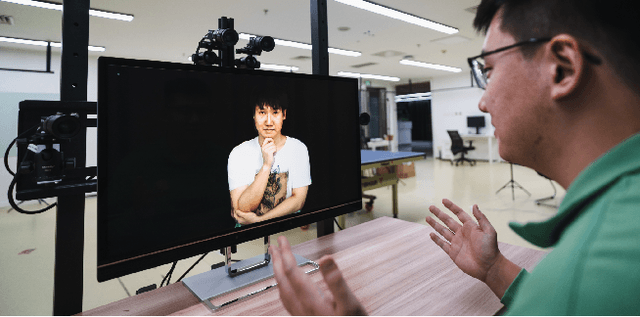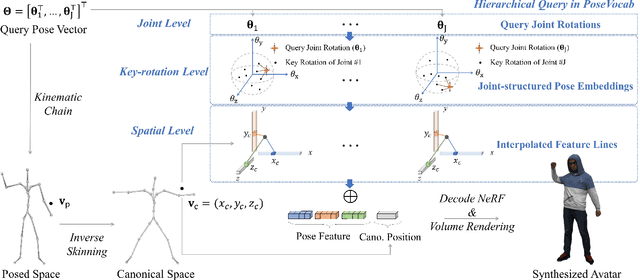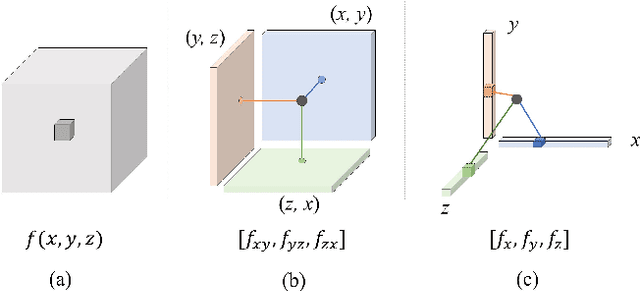Boyao Zhou
ManiVideo: Generating Hand-Object Manipulation Video with Dexterous and Generalizable Grasping
Dec 18, 2024



Abstract:In this paper, we introduce ManiVideo, a novel method for generating consistent and temporally coherent bimanual hand-object manipulation videos from given motion sequences of hands and objects. The core idea of ManiVideo is the construction of a multi-layer occlusion (MLO) representation that learns 3D occlusion relationships from occlusion-free normal maps and occlusion confidence maps. By embedding the MLO structure into the UNet in two forms, the model enhances the 3D consistency of dexterous hand-object manipulation. To further achieve the generalizable grasping of objects, we integrate Objaverse, a large-scale 3D object dataset, to address the scarcity of video data, thereby facilitating the learning of extensive object consistency. Additionally, we propose an innovative training strategy that effectively integrates multiple datasets, supporting downstream tasks such as human-centric hand-object manipulation video generation. Through extensive experiments, we demonstrate that our approach not only achieves video generation with plausible hand-object interaction and generalizable objects, but also outperforms existing SOTA methods.
Tele-Aloha: A Low-budget and High-authenticity Telepresence System Using Sparse RGB Cameras
May 23, 2024



Abstract:In this paper, we present a low-budget and high-authenticity bidirectional telepresence system, Tele-Aloha, targeting peer-to-peer communication scenarios. Compared to previous systems, Tele-Aloha utilizes only four sparse RGB cameras, one consumer-grade GPU, and one autostereoscopic screen to achieve high-resolution (2048x2048), real-time (30 fps), low-latency (less than 150ms) and robust distant communication. As the core of Tele-Aloha, we propose an efficient novel view synthesis algorithm for upper-body. Firstly, we design a cascaded disparity estimator for obtaining a robust geometry cue. Additionally a neural rasterizer via Gaussian Splatting is introduced to project latent features onto target view and to decode them into a reduced resolution. Further, given the high-quality captured data, we leverage weighted blending mechanism to refine the decoded image into the final resolution of 2K. Exploiting world-leading autostereoscopic display and low-latency iris tracking, users are able to experience a strong three-dimensional sense even without any wearable head-mounted display device. Altogether, our telepresence system demonstrates the sense of co-presence in real-life experiments, inspiring the next generation of communication.
Ins-HOI: Instance Aware Human-Object Interactions Recovery
Dec 15, 2023Abstract:Recovering detailed interactions between humans/hands and objects is an appealing yet challenging task. Existing methods typically use template-based representations to track human/hand and objects in interactions. Despite the progress, they fail to handle the invisible contact surfaces. In this paper, we propose Ins-HOI, an end-to-end solution to recover human/hand-object reconstruction via instance-level implicit reconstruction. To this end, we introduce an instance-level occupancy field to support simultaneous human/hand and object representation, and a complementary training strategy to handle the lack of instance-level ground truths. Such a representation enables learning a contact prior implicitly from sparse observations. During the complementary training, we augment the real-captured data with synthesized data by randomly composing individual scans of humans/hands and objects and intentionally allowing for penetration. In this way, our network learns to recover individual shapes as completely as possible from the synthesized data, while being aware of the contact constraints and overall reasonability based on real-captured scans. As demonstrated in experiments, our method Ins-HOI can produce reasonable and realistic non-visible contact surfaces even in cases of extremely close interaction. To facilitate the research of this task, we collect a large-scale, high-fidelity 3D scan dataset, including 5.2k high-quality scans with real-world human-chair and hand-object interactions. We will release our dataset and source codes. Data examples and the video results of our method can be found on the project page.
GaussianAvatar: Towards Realistic Human Avatar Modeling from a Single Video via Animatable 3D Gaussians
Dec 04, 2023



Abstract:We present GaussianAvatar, an efficient approach to creating realistic human avatars with dynamic 3D appearances from a single video. We start by introducing animatable 3D Gaussians to explicitly represent humans in various poses and clothing styles. Such an explicit and animatable representation can fuse 3D appearances more efficiently and consistently from 2D observations. Our representation is further augmented with dynamic properties to support pose-dependent appearance modeling, where a dynamic appearance network along with an optimizable feature tensor is designed to learn the motion-to-appearance mapping. Moreover, by leveraging the differentiable motion condition, our method enables a joint optimization of motions and appearances during avatar modeling, which helps to tackle the long-standing issue of inaccurate motion estimation in monocular settings. The efficacy of GaussianAvatar is validated on both the public dataset and our collected dataset, demonstrating its superior performances in terms of appearance quality and rendering efficiency.
GPS-Gaussian: Generalizable Pixel-wise 3D Gaussian Splatting for Real-time Human Novel View Synthesis
Dec 04, 2023Abstract:We present a new approach, termed GPS-Gaussian, for synthesizing novel views of a character in a real-time manner. The proposed method enables 2K-resolution rendering under a sparse-view camera setting. Unlike the original Gaussian Splatting or neural implicit rendering methods that necessitate per-subject optimizations, we introduce Gaussian parameter maps defined on the source views and regress directly Gaussian Splatting properties for instant novel view synthesis without any fine-tuning or optimization. To this end, we train our Gaussian parameter regression module on a large amount of human scan data, jointly with a depth estimation module to lift 2D parameter maps to 3D space. The proposed framework is fully differentiable and experiments on several datasets demonstrate that our method outperforms state-of-the-art methods while achieving an exceeding rendering speed.
Leveraging Intrinsic Properties for Non-Rigid Garment Alignment
Aug 18, 2023Abstract:We address the problem of aligning real-world 3D data of garments, which benefits many applications such as texture learning, physical parameter estimation, generative modeling of garments, etc. Existing extrinsic methods typically perform non-rigid iterative closest point and struggle to align details due to incorrect closest matches and rigidity constraints. While intrinsic methods based on functional maps can produce high-quality correspondences, they work under isometric assumptions and become unreliable for garment deformations which are highly non-isometric. To achieve wrinkle-level as well as texture-level alignment, we present a novel coarse-to-fine two-stage method that leverages intrinsic manifold properties with two neural deformation fields, in the 3D space and the intrinsic space, respectively. The coarse stage performs a 3D fitting, where we leverage intrinsic manifold properties to define a manifold deformation field. The coarse fitting then induces a functional map that produces an alignment of intrinsic embeddings. We further refine the intrinsic alignment with a second neural deformation field for higher accuracy. We evaluate our method with our captured garment dataset, GarmCap. The method achieves accurate wrinkle-level and texture-level alignment and works for difficult garment types such as long coats. Our project page is https://jsnln.github.io/iccv2023_intrinsic/index.html.
Control4D: Dynamic Portrait Editing by Learning 4D GAN from 2D Diffusion-based Editor
May 31, 2023Abstract:Recent years have witnessed considerable achievements in editing images with text instructions. When applying these editors to dynamic scene editing, the new-style scene tends to be temporally inconsistent due to the frame-by-frame nature of these 2D editors. To tackle this issue, we propose Control4D, a novel approach for high-fidelity and temporally consistent 4D portrait editing. Control4D is built upon an efficient 4D representation with a 2D diffusion-based editor. Instead of using direct supervisions from the editor, our method learns a 4D GAN from it and avoids the inconsistent supervision signals. Specifically, we employ a discriminator to learn the generation distribution based on the edited images and then update the generator with the discrimination signals. For more stable training, multi-level information is extracted from the edited images and used to facilitate the learning of the generator. Experimental results show that Control4D surpasses previous approaches and achieves more photo-realistic and consistent 4D editing performances. The link to our project website is https://control4darxiv.github.io.
PoseVocab: Learning Joint-structured Pose Embeddings for Human Avatar Modeling
May 14, 2023



Abstract:Creating pose-driven human avatars is about modeling the mapping from the low-frequency driving pose to high-frequency dynamic human appearances, so an effective pose encoding method that can encode high-fidelity human details is essential to human avatar modeling. To this end, we present PoseVocab, a novel pose encoding method that encourages the network to discover the optimal pose embeddings for learning the dynamic human appearance. Given multi-view RGB videos of a character, PoseVocab constructs key poses and latent embeddings based on the training poses. To achieve pose generalization and temporal consistency, we sample key rotations in $so(3)$ of each joint rather than the global pose vectors, and assign a pose embedding to each sampled key rotation. These joint-structured pose embeddings not only encode the dynamic appearances under different key poses, but also factorize the global pose embedding into joint-structured ones to better learn the appearance variation related to the motion of each joint. To improve the representation ability of the pose embedding while maintaining memory efficiency, we introduce feature lines, a compact yet effective 3D representation, to model more fine-grained details of human appearances. Furthermore, given a query pose and a spatial position, a hierarchical query strategy is introduced to interpolate pose embeddings and acquire the conditional pose feature for dynamic human synthesis. Overall, PoseVocab effectively encodes the dynamic details of human appearance and enables realistic and generalized animation under novel poses. Experiments show that our method outperforms other state-of-the-art baselines both qualitatively and quantitatively in terms of synthesis quality. Code is available at https://github.com/lizhe00/PoseVocab.
 Add to Chrome
Add to Chrome Add to Firefox
Add to Firefox Add to Edge
Add to Edge